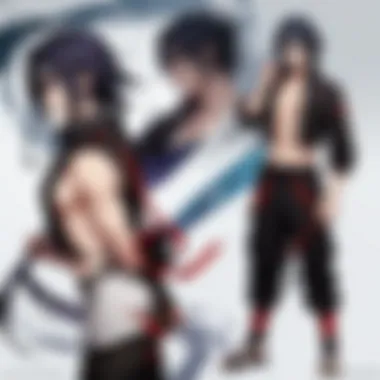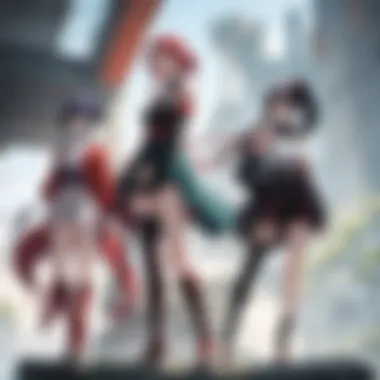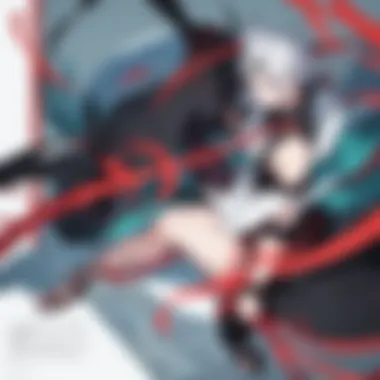An In-Depth Exploration of Naruto Shippuden


Intro
Naruto Shippuden, the much-lauded continuation of the original Naruto series, takes viewers into a more complex narrative landscape filled with deeper character motivations, intricate conflicts, and a broader exploration of themes that resonate beyond the screen. The series picks up roughly two and a half years after the original Naruto saga and does not shy away from confronting serious issues like loss, the cycle of hatred, and the meaning of friendship.
As we delve into this exploration, it is essential to understand that Naruto Shippuden builds upon its predecessor in multifaceted ways. It enriches character arcs, broadens the thematic palette, and deepens the storytelling techniques that define the series. The rich narrative arcs crafted in Shippuden have not only captivated audiences but also left a profound impact on the anime and manga culture.
Featured Series or Manga
Overview of the Series
Naruto Shippuden aired from 2007 to 2017, adapting the later chapters of Masashi Kishimoto's manga. This series enhances the existing narrative by shifting the focus to a more mature Naruto Uzumaki, who is now embarking on a journey filled with challenges and difficulties. With more significant stakes, the dynamics between characters evolve, creating an intricate web of relationships.
Key narrative arcs in the Shippuden series include the Kazekage Rescue Arc, the Search for Tsunade Arc, and the Fourth Great Ninja War. Each arc serves a purpose in advancing character development and uncovering broader themes. This differentiation between Naruto and Shippuden establishes a sense of progression, particularly in the lives of the characters and the unfolding plot.
Key Characters and Development
Naruto Shippuden introduces several pivotal characters while dealing with the evolution of established ones. The primary focus remains on Naruto and his journey to become Hokage while also wrestling with his identity and destiny. Accompanied by a well-rounded cast, including Sasuke Uchiha, Sakura Haruno, and Kakashi Hatake, the series highlights their growth and personal struggles.
- Naruto Uzumaki: A determined ninja tormented by his past, he seeks acceptance and desires to prove his worth to the village.
- Sasuke Uchiha: A character defined by conflict, his quest for revenge leads him down a dark path, exploring deeper themes of friendship and betrayal.
- Sakura Haruno: Initially portrayed as a supporting character, her development into a formidable ninja showcases the series' dedication to character growth.
"Naruto Shippuden’s strength lies in its ability to juxtapose personal growth against the backdrop of a crumbling world."
The series persists in challenging the characters, testing their limits, both physically and emotionally, while redefining their relationships and personal growth.
Character Analysis
Major Characters
Focusing on character depth forms the backbone of Naruto Shippuden. Character complexities unfold through various trials that the main figures face. Most notable arcs intricately explore themes of redemption, rivalry, and sacrifice.
- Kakashi Hatake: A mentor to Naruto and his team, Kakashi’s backstory is gradually revealed, enriching the overall narrative.
- Pain (Nagato): As an antagonist, he embodies the series' theme of loss, seeking a painful path to peace through destruction.
Character Arcs and Growth
Character arcs are essential in Shippuden. Each character undergoes significant transformations. Naruto’s transformation from an outcast to a leader symbolizes hope and persistence. Sasuke’s arc, contrastingly, reflects the consequences of vengeance. Sakura finds strength and independence as she evolves from dependency to self-reliance.
Thematic Exploration
Main Themes and Messages
Naruto Shippuden delves into various themes that connect profoundly with audiences. Central themes include:
- Friendship and Bonds: The series emphasizes the importance of relationships and community in shaping an individual’s journey.
- The Cycle of Hatred: Through various character narratives, it reflects how past traumas can influence future generations.
- Identity and Purpose: Characters grapple with their sense of belonging and why they fight, leading to a more profound understanding of themselves.
Cultural Context and Influences
Both the series and the manga reflect cultural nuances that resonate in Japan and beyond. The themes often draw parallels with Japan’s own societal issues, such as identity struggles, loyalty, and acceptance. The intricate storytelling in Naruto Shippuden showcases how anime can engage with complex themes, thereby elevating the discussion around it.
In summary, Naruto Shippuden stands as a milestone within the anime genre. Its exploration of deep-rooted themes coupled with compelling character arcs creates a compelling narrative that continues to captivate audiences worldwide.
Prologue to Naruto Shippuden


Understanding the context of Naruto Shippuden is vital for grasping its significance in the anime landscape. This series builds on the foundation laid by its predecessor, Naruto, and takes the narrative, themes, and character arcs to a more profound level. The importance of introducing Naruto Shippuden lies in its exploration of growth—not just for the characters, but for the audience as well. The series presents themes of maturity, the complexities of relationships, and the challenges of becoming stronger.
Overview of the Series
Naruto Shippuden continues the story of Naruto Uzumaki, who has grown into a young ninja striving to protect his village and achieve his dream of becoming Hokage. The series picks up two and a half years after the events of Naruto, showcasing a more mature tone and a darker atmosphere. With 500 episodes, it navigates through various arcs that enrich the lore of the universe, introducing new characters and revisiting familiar faces with evolved backstories.
The series not only focuses on Naruto but encompasses his friends like Sakura Haruno and Sasuke Uchiha, showcasing their development as they confront personal demons and external threats. Each episode adds layers to their lives, building a tapestry that reveals the essence of perseverance, dreams, and the consequences of choices.
Historical Context
Naruto Shippuden premiered in 2007 and ran for several years, culminating in its finale in 2017. The anime's adaptation diverged from the manga, allowing for expanded content that included filler episodes and original storylines. This choice was significant as it provided opportunities for character development and world-building that were not present in the original manga. As an anime, it has drawn considerable attention from a global audience, making impacts on both Western and Eastern cultures.
In the context of anime history, Naruto Shippuden emerged during a period when themes of friendship and personal growth were becoming prominent. The show reflects the struggles and aspirations of its characters, resonating with many viewers. Furthermore, it played a pivotal role in the establishment of shonen anime in mainstream popular culture, influencing newer generations of series and creators.
“Naruto Shippuden is not just an anime; it is a phenomenon that shaped the landscape of storytelling in this genre.”
Through examining this series, one can uncover the complexities that make it a phenomenon worth discussing. The depth of its narrative and character arcs contributes to its status as a landmark within the anime genre.
Narrative Structure
Understanding the narrative structure of Naruto Shippuden is essential for grasping how the series captivates its audience. The narrative is a mix of episodic content and larger story arcs, which provides a depth that enriches viewers’ experience. This structure influences how themes are presented, how character development unfolds, and ultimately impacts the pacing and tension throughout the series.
Episodic vs. Arcs
The series showcases an interplay between episodic storytelling and arc-based narratives. In episodic segments, self-contained stories are explored, offering viewers a momentary focus on individual characters or events. These episodes often delve into lessons, comedic moments, or minor conflicts that may not heavily influence the overall narrative. For example, episodes featuring Naruto's interactions with his friends or village members serve to build the world and develop character relationships.
On the other hand, story arcs span multiple episodes and connect more deeply with the overarching plot. These arcs allow for a more intricate exploration of themes, such as redemption and struggle. An instance of this is the Pain Arc, which significantly develops Naruto and his ideology about peace and friendship. Moreover, the transition from episodic to arc narrative heightens viewer anticipation as they align with character journeys and conflicts.
This dual narrative structure allows the series to maintain engagement through variety. Fans are drawn in by humorous moments while also being emotionally invested in serious arcs.
Pacing and Tension
Pacing plays a critical role in maintaining tension throughout Naruto Shippuden. The creators utilize various techniques, such as varying episode lengths and strategic cliffhangers, to manipulate how viewers experience the story. For instance, slower pacing during character introspection promotes emotional depth, allowing viewers to connect with their struggles and victories.
Conversely, action-packed scenes are typically fast-paced, driving excitement and urgency. The contrast between fast and slow segments keeps viewers on their toes. Moments of tension are carefully crafted, often leading to significant battles or events. This design builds up suspense and reward as unresolved questions compel viewers to continue watching.
This nuanced pacing fosters a suspenseful atmosphere that is crucial for the series’ emotional weight and philosophical depth.
Themes Explored in Naruto Shippuden
In Naruto Shippuden, various themes play a crucial role in shaping the narrative and character arcs. This section analyzes three major themes: the nature of friendship, the quest for identity, and perseverance and redemption. These themes are not just motifs; they drive the character's motivations, relationships, and overall story arc.
The Nature of Friendship
Friendship is a pillar that supports the Naruto Shippuden universe. The relationships between characters are intricate and evolve throughout the series. Naruto Uzumaki exemplifies how strong friendships can motivate personal growth and resilience. For him, bonds with teammates like Sakura Haruno and Sasuke Uchiha help him overcome numerous challenges. The series demonstrates that friends can provide emotional strength and act as catalysts for change.
Moreover, friendships often clash with enemies. Characters like Gaara and Naruto initially appear as rivals. However, their understanding grows over time, leading to a transformation in their outlook. This evolution highlights how friendship can transcend past animosities, showcasing a genuine camaraderie that fosters trust and unity. As friendships strengthen, the narrative emphasizes the importance of loyalty and mutual respect, asserting that these ties are essential for overcoming obstacles.
The Quest for Identity
The search for identity represents another significant theme in Naruto Shippuden. Each character embarks on their journey of self-discovery. Naruto, coming from a background of rejection, strives to carve out his place in the world. His determination to be recognized as Hokage embodies this quest. As he confronts various adversaries, he also faces questions about his worth and desires. The narrative illustrates that identity is often shaped through adversity and the choices one makes.
Sasuke Uchiha’s path is starkly different yet equally profound. Consumed by vengeance, his identity becomes entangled in a quest for retribution against his brother, Itachi. This arc emphasizes the struggle between personal revenge and the need for closure and acceptance. The series ultimately suggests that defining oneself is a multifaceted process influenced by external relationships and internal conflicts.


Perseverance and Redemption
Perseverance is a theme deeply woven into the fabric of Naruto Shippuden. Characters continually face daunting challenges yet display remarkable resilience. Naruto’s journey is filled with trials, yet his unwavering spirit often leads him to success against the odds. This quality resonates with audiences, who see reflections of their struggles in his determination.
Redemption is closely linked to perseverance. Numerous characters, including Sasuke and even former adversaries like Orochimaru, seek redemption for past actions. Their arcs illustrate that the journey towards redemption can be long and cumbersome but is achievable through self-reflection and effort. The series promotes the notion that everyone has the capacity for change, emphasizing that past mistakes do not have to define one’s future.
In summary, the themes explored in Naruto Shippuden create a rich tapestry that enhances character development and narrative depth. They resonate with viewers and readers, inviting them to reflect on their relationships, struggles, and the quest for self-understanding.
Character Development
Character development is central to Naruto Shippuden and plays a crucial role in illustrating the thematic richness of the series. The growth of characters not only reflects their personal journeys but also mirrors the evolution of important relationships within the narrative. In this section, we will explore how character arcs contribute to the overall impact of the series on its viewers, particularly focusing on the journeys of key characters. Strong character arcs lead to more invested viewers, making the story relatable and meaningful.
Naruto Uzumaki's Transformation
Naruto Uzumaki's transformation is a focal point for understanding personal growth within the series. Initially portrayed as an underdog, Naruto struggles with feelings of loneliness and isolation due to his status as a jinchuriki. However, as the narrative progresses, he evolves into a confident leader and a skilled ninja. This change is not merely physical; it encapsulates emotional and psychological growth as well.
Naruto learns the value of friendship, perseverance, and forgiveness. His desire for acknowledgment from his peers transitions into a dedication to protect his village, showcasing his growth from selfish aspirations to selfless motives. This maturation process, including his struggles and triumphs, resonates with fans as they see aspects of their own journeys reflected in Naruto’s transformation.
Sasuke Uchiha's Evolving Arc
Sasuke Uchiha presents a dark counterpoint to Naruto's development. His arc is filled with trauma and betrayal, largely stemming from the massacre of his clan. Initially motivated by a quest for revenge against his brother Itachi, Sasuke's character embodies the theme of vengeance versus redemption. The complexity of Sasuke's journey engages viewers, as it raises questions about morality, loss, and the impact of choices.
Throughout Shippuden, Sasuke's motivations shift, and he often finds himself at odds with former friends. This evolution highlights the internal conflict he experiences. Ultimately, Sasuke’s journey towards redemption, acceptance of allyship, and reconciliation with his past brings depth not just to his character but to the entire series. His character arc complicates the notion of a hero, creating a dynamic narrative that keeps audiences captivated.
Supporting Characters and Their Roles
Supporting characters are indispensable in shaping the narrative around Naruto and Sasuke. Characters such as Sakura Haruno, Kakashi Hatake, and Gaara serve as essential narratives that expand upon the main themes of the series. Each supporting character showcases unique traits that enhance the emotional weight of the storyline.
- Sakura Haruno evolves from a love-struck girl to a formidable kunoichi, illustrating empowerment and growth.
- Kakashi Hatake, as a mentor, embodies wisdom and guide, impacting both Naruto and Sasuke in profound ways.
- Gaara’s transition from antagonist to ally emphasizes redemption and the importance of understanding.
These characters enrich the tapestry of Naruto Shippuden, each contributing to the themes of friendship, redemption, and the search for one's identity. Their development is crucial; it provides depth and offers viewers multiple perspectives on similar struggles.
The relationships and developments of these characters intertwine, allowing viewers to grasp the multifaceted nature of growth and the impacts of their surroundings.
Cultural Impact
The cultural impact of Naruto Shippuden cannot be overstated. This series not only enriched the anime landscape but also influenced broader pop culture globally. It introduced unique storytelling methods, character dynamics, and themes that resonated with many viewers, setting a new standard for narrative depth in anime.
Influence on Modern Anime
Naruto Shippuden ushered in a wave of change in the anime industry. Its blend of action, emotion, and character development reshaped how future series approached storytelling.
- Character-Driven Plotlines: Naruto Shippuden emphasized deep character arcs over mere episodic conflicts. This shift encourages newer anime to focus more on character growth, rather than relying solely on action-driven plots.
- Complex Villains: The series introduced multi-dimensional antagonists. Characters like Pain and Obito highlight that villains can possess compelling backstories and motivations, influencing shows like Attack on Titan and My Hero Academia to develop similar strategies for their villains.
- Theme Expanse: Themes such as friendship, perseverance, and identity are prevalent in many modern anime, inspired by the foundational narratives established by Naruto Shippuden.
"The intricate relationships and developments of the characters pave the way for more nuanced storytelling in anime."
Global Reception and Fanbase
The reception of Naruto Shippuden was global and impactful. From the initial broadcast, the series cultivated a loyal worldwide fanbase, contributing to its longevity and relevance.
- Diverse Audience Recognition: Fans from different cultural backgrounds found relatability in the characters’ struggles and growth. This universality is crucial in making the series accessible to a global audience.
- Convention Culture: Naruto Shippuden played a pivotal role in the rise of anime conventions, where fans gather to celebrate their shared interests. Events often feature panels, cosplay, and merchandise that thrives off the franchise’s popularity.
- Online Communities: Platforms like Reddit and dedicated social media groups foster discussions, fan art, and more. These online spaces allow fans to connect and share their interpretations of the series, driving further engagement and interest.
Art and Animation Style


The art and animation style of Naruto Shippuden plays a crucial role in its storytelling and character portrayal. Visual elements elevate the emotional engagement and enhance the narrative experience. The aesthetic coherence between character design, background art, and animation techniques does not just serve decorative purposes but also reflects the themes and battles within the storyline.
Character Design and Aesthetics
Character design in Naruto Shippuden is meticulously crafted. Each character has a distinctive look that conveys their personality and development. From Naruto Uzumaki’s spiky blonde hair to the dark attire of characters like Orochimaru, these designs create immediate visual identifiers for audiences.
The aesthetics extend beyond mere visuals. For instance, emotional states often influence character design choices. Anger might be reflected in a character’s sharper features, while softer designs can indicate vulnerability. This visual storytelling allows viewers to grasp character interactions more intuitively.
Moreover, the use of color has a significant implication in character design. Bright colors often signify optimism and youth, while darker tones may underline despair or malice. This indicates the emotional landscape portrayed in the series and aligns with its overarching themes.
Animation Techniques
Animation techniques utilized in Naruto Shippuden facilitate dynamic storytelling. The series enhances dramatic scenes through a mix of traditional cel animation and advanced digital techniques. Movement fluidity is apparent during battle sequences, which are often fast-paced and visceral.
Different animation techniques contribute to the series' vibrancy. For example, slow-motion effects can emphasize the gravity of critical moments, whereas rapid cuts may evoke chaos or urgency. Using varying frame rates also helps to highlight significant emotional beats.
Transitions between fight scenes and dialogue-heavy segments are handled with care, which maintains viewer engagement. Key events are often marked with distinctive animations, such as elemental effects in combat, further enriching the visual narrative.
"The unique blend of well-thought-out character design and animation techniques makes Naruto Shippuden visually engaging, ensuring the series remains prominent in anime discussions."
Music and Sound
Music and sound in Naruto Shippuden play an integral role in crafting the series' emotional depth and enhancing the narrative experience. The auditory elements not only elevate dramatic moments but also shape character identities and themes throughout the anime. This section delves into how the score and voice acting contribute to the storytelling and overall impact of the series.
Score Composition and Themes
The score of Naruto Shippuden was primarily composed by Yasuharu Takanashi. His work in this series is notable for its ability to convey complex emotions and set the tone for various scenes. The music employs a mix of traditional Japanese instruments along with modern orchestral sounds. Such compositions help to create a unique atmosphere that reflects the series' cultural roots.
Specific themes recur in the score, often associated with particular characters or pivotal moments. For instance, the motif for Naruto is characterized by a blend of hope and determination, mirroring his journey from a troubled child to a powerful ninja. This thematic approach allows viewers to establish a deeper connection with the characters. Moreover, Takanashi's use of minor chords often underscores darker moments, adding weight to conflicts and challenges.
"The music in Naruto Shippuden is not just background noise; it is a vital narrative device that brings the story to life."
Voice Acting and Localization
Voice acting is another crucial aspect of Naruto Shippuden. It helps to breathe life into the characters, making them relatable and memorable. The Japanese cast, including Junko Takeuchi as Naruto and Noriaki Sugiyama as Sasuke, deliver performances that embody their characters' emotions brilliantly. This adds layers to their struggles and achievements, contributing significantly to the audience's investment in the story.
Localization is essential for engaging international audiences. Different language versions may adapt dialogue to resonate with local cultures while aiming to preserve the original intent. The English dub, for example, has created its own fanbase, owing to its talented cast and effective voice direction. Choices made during localization can affect how certain characters are perceived across different cultures, influencing the series' global reception.
In summary, music and sound in Naruto Shippuden are not mere embellishments; they are foundational elements that enhance the viewing experience. From the emotional weight of the score to the depth of characters brought forth through voice acting, these auditory components are essential in understanding the series' impact within the anime landscape.
End
The conclusion of an article serves as the final opportunity to reinforce the key themes and insights presented throughout the examination. In the context of Naruto Shippuden, it consolidates the exploration of the series by summarizing its legacy and implications for the broader anime landscape. This section underscores the relevance of Naruto Shippuden in contemporary discussions of narrative structure, character development, and thematic depth.
Legacy of Naruto Shippuden
Naruto Shippuden has left an indelible mark on the anime and manga communities. It has not only influenced the way future series are developed but has also created a substantial cultural phenomenon. The series has become synonymous with coming-of-age narratives in anime, articulating complex themes of ambition, sacrifice, and growth. Naruto Uzumaki, as the series' protagonist, embodies the struggle against adversity, a message resonating with audiences worldwide.
The legacy also extends beyond entertainment. Fans have created vibrant communities, with discussions on platforms such as Reddit and social media. The character arcs and intricate storytelling often inspire analysis and fan theories, strengthening the bond between the series and its audience.
"Naruto Shippuden captures the essence of perseverance, making it a relatable story for diverse demographics."
Future of the Franchise
As Naruto Shippuden's narrative reaches its conclusion, the franchise continues to evolve. Spin-offs and new content, such as Boruto: Naruto Next Generations, aim to capture the next generation while honoring the foundational elements of its predecessor. These iterations reveal the franchise's adaptability, addressing contemporary issues while retaining core themes of friendship and identity.
The popularity of the franchise suggests that it is far from over. Fans eagerly anticipate new films, manga chapters, and adaptations, indicating a sustained interest. In an era of digital media, where accessibility has increased, the potential for reaching newer audiences continues to grow. Understanding these dynamics is crucial for both fans and creators as they navigate the evolving landscape of anime.
In summary, the conclusion emphasizes how Naruto Shippuden remains not just a story of ninja battles and adventures, but a profound exploration of personal growth. It invites continued engagement from both existing fans and newcomers, ensuring its place in the history of anime.



